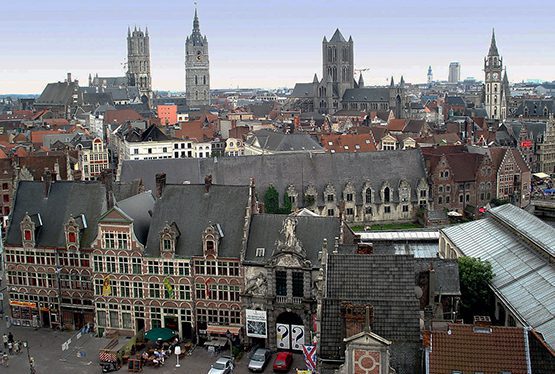How to Build a Skyline at Human Scale

Buildings touch the ground, and the business of resting on the ground, rather than crushing, mutilating, or annihilating it, is one fundamental part of the architectural task. But buildings also touch the sky, and in doing so they create one of the most significant boundaries in our world—the skyline, which is the boundary between the city and the heavens.
Traditional builders were very respectful towards this boundary. Their buildings were designed to meet the sky with cheerful gestures, wearing decorative crowns, reaching upwards with the prayerful fingers of the minarets or the questioning needles of the spires. Blunt stubs of flattened masonry might sometimes be necessary for military purposes. But they were never approved for use in the city, where every building needed a hat that would put its social nature on display.
This attitude to the skyline is one of the most important reasons for the charm of the old cities of Europe and the Middle East. Even today you can capture glimpses of this charm, for instance in the skyline of Ghent, so proud of its markets and merchandise, so intent on celebrating the guilds, congregations, schools, and colleges that throw their stone hats in the air.

Only from afar is a similar effect to be observed in the downtown of American cities, where vast lumps of steel and glass stand stark and sheer against the horizon, with perhaps here and there, in the old skyscrapers with their caps of alloy, some semblance of the joyful skylines of the old world. And when high-rise buildings, designed to look like children’s toys or kitchen gadgets, are introduced into those old world cities, the result, as in London today, is a heartbreaking vision of a dignified old face, beaten up by hooligans.
The horizontal roof was one of the innovations of which the modernists were most proud. Le Corbusier saw the flat roof of the Villa Savoye as a proof of the new aesthetic, and the fact that it leaked, and that the whole house beneath it was soon to become uninhabitable and an object of litigation, was a matter of indifference to him. The house, he told us, is a “machine for living in.” He meant that it was to be lived in by machines, not by those petulant and comfort-hungry creatures known as humans.
The skyline of the old city was not created by spires, domes and minarets only. It was created most of all by the rows of pitched roofs on which these decorative additions cast their endearing shadows.
The pitched roof, like the window, was one of those great discoveries that any child could have made, but which, like the window, required a vast amount of research before architects could dispense with it. This research has enabled architects to design sealed buildings whose windows cannot be opened, which require constant heating and cooling, and which generally fall apart at the joints and leak from the roof—all positive attributes that necessitate demolition and rebuilding every 20 or 30 years.
Pitched roofs and windows, by contrast, produce buildings that last forever, and which can be constructed without the advice of an architect, as at Ghent: They are a disaster for the profession and it is no wonder that every effort is being made to forget how to construct them.
The pitched roof has a gable, which lends itself to decoration. It has corners where statues can stand or finials sprout. It carries tiles that make rippling shadows and very often has a terracotta crest along the apex, which stitches the two slopes together. It can be punctured by attic windows, to delightful effect, and creates interesting interiors that remind their occupants of the sky above. All in all it is an aesthetic triumph, all the greater for never having been thought of in that way.
Look at the architecture journals and blogs to see how roofs are now conceived and your heart will sink. As always there is only one lesson that architects have learned, which is that it is vital to be original, especially if real knowledge stands in the way.
Roger Scruton is The American Conservative’s New Urbanism Fellow.
The New Urbs series is supported by the Richard H. Driehaus Foundation.
Comments